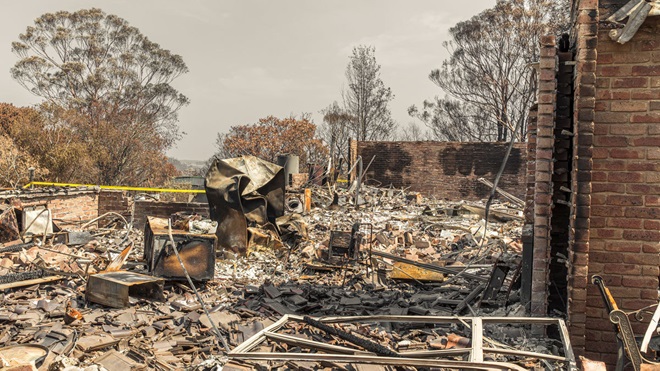The Bureau of Meteorology is expecting one of the hottest summers on record this year, so Australians need to be prepared for extreme weather.
The hot temperatures mean a high risk of bushfires, especially for drought-affected regions. Floods and wet ground in other regions over the last years supported the enhanced growth of vegetation which also means a higher risk of fires.
"Natural disasters can be one of the most complex issues to navigate when it comes to insurance," says CHOICE insurance expert Jodi Bird.
"There are some simple things you can do right now to make things easier should you become affected by a bushfire and need to make a claim."
On this page:
- 1. Make sure your insurance documents are on hand
- 2. Check your cover
- 3. Take photos of everything
- 4. Contact your insurer
- 5. Prepare for next time
1. Make sure your insurance documents are on hand
If you have hard copies of your insurance documents, make sure they're packed in your bag ready to take with you if you need to evacuate your home. Having paper copies on hand, as well as easy access to digital versions, will make them easier to refer to if you need to speak to your insurer.
2. Check your cover
If you're not sure exactly what you're covered for, now is the time to find out. Get to know the details of your policy inside and out, including what you may not be covered for. All of this information will be in your product disclosure statement (PDS) given to you when you bought the cover.
Keep in mind that many insurance policies come with waiting periods for bushfire, usually 48–72 hours
If you think you want to take out home insurance cover for the immediate future, keep in mind that many insurance policies come with waiting periods for bushfire, usually 48–72 hours. You'll have to serve this waiting period if you weren't previously insured, are upgrading your cover, or are increasing your sum insured amount.
3. Take photos of everything
When it comes to insurance claims, your smartphone is your friend. Take photos all across your home now – major features of the property, valuable possessions and anything that can help you demonstrate the before and after.
Also take photos or make hard copies of any receipts for larger items in case you need to prove their value.
Store these photos in the 'cloud', which means you'll be able to access them anytime from any internet-connected device, no matter where you are. If you need to make a claim and it's safe to do so, take extensive photos of the damage.
4. Contact your insurer
Don't worry about making a claim until you and your property are safe and secure.
Once you're ready, bear in mind that many insurers may be experiencing high call volumes, so be patient. You may want to contact your insurer via phone or online, depending on the circumstances and claims process.
Whichever way you proceed, it's important that you keep a record of all interactions you have with your insurer. If necessary, they'll send someone to do initial make-safe repairs to prevent further damage. Our guide to making a claim on home and contents insurance can help make the process less stressful.
How to make a complaint
If you believe your claim has been unfairly refused, contact the insurer's internal dispute resolution team. If you don't get a satisfactory result, contact the Australian Financial Complaints Authority (AFCA).
Other places to get help include:- Insurance Law Service, phone 1300 663 464
- Mob Strong, Debt Help for Aboriginal and Torres Strait Islander peoples, phone 1800 808 488.
5. Prepare for next time
'Fire cover' is a standard inclusion in home and contents insurance, but what does it actually mean? It turns out that what you're covered for is defined in many different ways.
Following our investigation in early 2020 in the wake of catastrophic bushfires in many parts of Australia, some insurers have added much-needed improvements to their fire cover.
While fire cover would normally cover bushfire and grassfire, many insurers now also cover damage caused by heat, ash, smoke or soot from a nearby bushfire, even if your property isn't directly burned. Be sure to check the PDS for specifics.
Check that you're insured for enough to cover the cost of your home and all your belongings – and update your cover if you need to
You should also check that you're insured for enough to cover the cost of your home and all your belongings – and update your cover if you need to or shop around for a better deal.
Rising building costs
Most insurers automatically increase your sum insured amount every year to account for inflation, but it pays to do your own assessment of potential rebuilding costs.
The costs to rebuild often increase after a natural disaster, as demand for builders and materials surges when a large number of buildings have been damaged. Older houses that have been damaged may also need to be upgraded to meet higher building standards.
Take your insurer's calculator with a grain of salt and consider getting an estimate from a builder or quantity surveyor.
We're on your side
For more than 60 years, we've been making a difference for Australian consumers. In that time, we've never taken ads or sponsorship.
Instead we're funded by members who value expert reviews and independent product testing.
With no self-interest behind our advice, you don't just buy smarter, you get the answers that you need.
You know without hesitation what's safe for you and your family. And our recent sunscreens test showed just how important it is to keep business claims in check.
So you'll never be alone when something goes wrong or a business treats you unfairly.
Learn more about CHOICE membership today
Stock images: Getty, unless otherwise stated.



